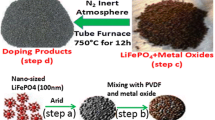Abstract
In this work, atomistic simulation method based on a simple force filed model is applied to observe the concerted motion of lithium ions in the perfect lattice of LiFePO4 cathode material. The simulation is carried out at a series of increasingly elevated temperature in a super cell containing 64 unit cells. The superimposed Li+ trajectory at all timeframes offers an intuitive, reliable image of the Li+ migration in crystal lattice, which gives us new insight into the migration mechanism of lithium ion in the lattice of LiFePO4. It reveals that at lower temperatures, lithium ion propagates along the b-axis and follows zigzag channels consisting of alternating 4a-4c hopping and 8d-8d stretching paths. At the temperature higher than 1050 K, Li-Fe collaborative movement is responsible for the lithium ion flow along the a-axis and the c-axis, namely, the alternating 4a Li -4c tetra-c-4d Fe site-4a Li site route and the alternating 4a Li site -4c Fe site-4a Li site route. This Li-Fe collaborative movement, normally referred to as anti-site, is better to be described as site disordering. At the same time, the wandering Fe ion at the 4c unoccupied tetrahedral position will also generate blocking effect that deteriorates the lithium ions migration along the b-axis. The minimum energy barrier of LiFePO4 cathode material is about 0.55 eV along the b-axis, and the estimated lithium ion diffusion coefficient at room temperature is estimated at ca. 3.67 × 10-12 cm2·s-1.












Similar content being viewed by others
References
Padhi AK, Nanjundaswamy KS, Goodenough JB (1997) Phospho‐olivines as Positive‐Electrode Materials for Rechargeable Lithium Batteries. J Electrochem Soc 144:1188–1194
Takahashi M, Tobishima SI, Takei K, Sakurai Y (2002) Reaction behavior of LiFePO4 as a cathode material for rechargeable lithium batteries. Solid State Ionics 148:283–289
Hsu KF, Tsay SY, Hwang BJ (2004) Synthesis and characterization of nano-sized LiFePO4cathode materials prepared by a citric acid-based sol–gel route. J Mater Chem 14:2690–2695
Doeff MM, Hu YQ, McLarnon F, Kostecki R (2003) Effect of Surface Carbon Structure on the Electrochemical Performance of LiFePO[sub 4]. Electrochem Solid-State Lett 6:A207
Huang H, Yin SC, Nazar LF (2001) Electrochem Solid-State Lett 4(10):A170
Croce F, D’Epifanio A, Hassoun J, Deptula A, Olczac T, Scrosati B (2002) Electrochem Solid-State Lett 5:A47
Chung SY, Bloking JT (2002) Electronically conductive phospho-olivines as lithium storage electrodes. Nat Mater 1:123–128
Ravet N, Chouinard Y, Magnan JF, Besner S, Gauthier M, Armand M (2001) Electroactivity of natural and synthetic triphylite. J Power Sources 97-98:503–507
Morgan D, Van der Ven A, Ceder G (2004) Electrochem Solid-State Lett 7(2):A30
Zhang PX, Wu YP, Zhang DY, Xu QM, Liu JH, Ren XZ et al (2008) Molecular Dynamics Study on Ion Diffusion in LiFePO4Olivine Materials. J Phys Chem A 112:5406–5410
Plimpton S 1995 J. Comp. Phys. 117 1 website: http://lammps.sandia.gov
Islam MS, Driscoll DJ, Craig AJF, Peter RS (2005) Atomic-Scale Investigation of Defects, Dopants, and Lithium Transport in the LiFePO4Olivine-Type Battery Material. Chem Mater 17:5085–5092
Craig AJF, Hart Prieto VM, Islam MS (2008) Chem Mater 20:5907
Mitchell PJ, Fincham D (1993) J Phys Condens Matter 5:1031
Dick RG, Overhauser AW (1958) Theory of the Dielectric Constants of Alkali Halide Crystals. Phys Rev 112:90–103
Lee S, Park SS (2012) Atomistic Simulation Study of Mixed-Metal Oxide (LiNi1/3Co1/3Mn1/3O2) Cathode Material for Lithium Ion Battery. J Phys Chem C 116:6484–6489
Panchmatia PM, Orera A, Rees GJ, Smith ME, Hanna JV, Slater PR et al (2011) Angew Chem Int Ed 123:9500
Panchmatia PM, Armstrong AR, Bruce PG, Islam MS (2014) Lithium-ion diffusion mechanisms in the battery anode material Li1+xV1−xO2. Phys Chem Chem Phys 16:21114–21118
Tealdi C, Spreafico C, Mustarelli P (2012) Lithium diffusion in Li1−xFePO4: the effect of cationic disorder. J Mater Chem 22:24870
Slanne M, Marrochelli M, Watson GW (2012) Cooperative Mechanism for the Diffusion of Li+Ions in LiMgSO4F. J Phys Chem C 116:18618–18625
Wood SM, Eames C, Kendrick E, Islam MS (2015) Sodium Ion Diffusion and Voltage Trends in Phosphates Na4M3(PO4)2P2O7(M = Fe, Mn, Co, Ni) for Possible High-Rate Cathodes. J Phys Chem C 119:15935–15941
Hua BY, Tao GH (2015) Molecular dynamics simulations on lithium diffusion in LiFePO4: the effect of anti-site defects. J Mater Chem A 3:20399–20407
Yang SF, Song YN, Zavalij PY, Whittingham MS (2002) Electrochem Commun 4:239
PrakashBadi S, Wagemaker M, Ellis BL, Singh DP, Borghols WJH, Kan WH et al (2011) J Mater Chem 21:10085
Chen JJ, Vacchio MJ, Wang SJ, Chernova N, Zavalij PY, Whittingham MS (2008) The hydrothermal synthesis and characterization of olivines and related compounds for electrochemical applications. Solid State Ionics 178:1676–1693
Yang SF, Zavalij PY, Whittingham MS (2001) Electrochem Commun 3:505
Yang SF, Song YN, Ngala K, Zavalij PY, Whittingham MS (2003) Performance of LiFePO4 as lithium battery cathode and comparison with manganese and vanadium oxides. J Power Sources 119-121:239–246
Yang JJ, Tse JS (2011) Li Ion Diffusion Mechanisms in LiFePO4: An ab Initio Molecular Dynamics Study. J Phys Chem A 115:13045–13049
Noda Y, Nakano K, Takeda H, Kotobuki M, Lu L, Nakayama M (2017) Computational and Experimental Investigation of the Electrochemical Stability and Li-Ion Conduction Mechanism of LiZr2(PO4)3. Chem Mater 29:8983–8991
Funding
This study received support from 973 Fundamental research program from the ministry of science and technology of China (grant number 2010CB635116), NSFC project 21173190, Ningbo Science and Technology Bureau Project 2017A610023, Zhejiang Provincial Natural Science Foundation of China Y13B010020, and K. C. Wong Magna Fund in Ningbo University.
Author information
Authors and Affiliations
Corresponding author
Additional information
Publisher’s note
Springer Nature remains neutral with regard to jurisdictional claims in published maps and institutional affiliations.
Rights and permissions
About this article
Cite this article
Dai, K., Gu, F., Wang, Q. et al. The new insight into the lithium migration mechanism of LiFePO4 by atomic simulation method. Ionics 27, 1477–1490 (2021). https://doi.org/10.1007/s11581-021-03940-2
Received:
Accepted:
Published:
Issue Date:
DOI: https://doi.org/10.1007/s11581-021-03940-2




